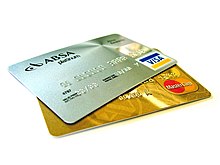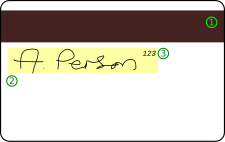Payment card: Difference between revisions
Enthusiast01 (talk | contribs) No edit summary |
Enthusiast01 (talk | contribs) No edit summary |
||
| Line 10: | Line 10: | ||
<li>Cardholder's name |
<li>Cardholder's name |
||
</ol>]] |
</ol>]] |
||
A '''payment card''' is a card that can be used by a cardholder and accepted by a merchant to make a [[payment]] for a purchase or in payment of some other obligation. |
|||
There several types of payment cards in the marketplace which have several features in common. Payment cards are embossed plastic cards the size of which comply with [[ISO/IEC 7810]] ID-1 standard and have an embossed [[bank card number]] conforming with the [[ISO/IEC 7812]] numbering standard. |
|||
==Types== |
==Types== |
||
Typically, a payment card is electronically linked to an account or accounts |
Typically, a payment card is electronically linked to an account or accounts belonging to the cardholder. These accounts may be [[deposit account]]s or loan or credit accounts. There are a number of payment cards including: |
||
===Credit card=== |
===Credit card=== |
||
Revision as of 21:05, 28 June 2012


- Issuing bank logo
- EMV chip
- Hologram
- Card number
- Card brand logo
- Expiration date
- Cardholder's name
A payment card is a card that can be used by a cardholder and accepted by a merchant to make a payment for a purchase or in payment of some other obligation.
There several types of payment cards in the marketplace which have several features in common. Payment cards are embossed plastic cards the size of which comply with ISO/IEC 7810 ID-1 standard and have an embossed bank card number conforming with the ISO/IEC 7812 numbering standard.
Types
Typically, a payment card is electronically linked to an account or accounts belonging to the cardholder. These accounts may be deposit accounts or loan or credit accounts. There are a number of payment cards including:
Credit card
A credit card is part of a system of payments named after the small plastic card issued to users of the system. It is a card entitling its holder to buy goods and services based on the holder's promise to pay for these goods and services.[1] The issuer of the card grants a line of credit to the consumer (or the user) from which the user can borrow money for payment to a merchant or as a cash advance to the user.
A credit card is different from a charge card, where a charge card requires the balance to be paid in full each month. In contrast, credit cards allow the consumers to 'revolve' their balance, at the cost of having interest charged. Most credit cards are issued by local banks or credit unions, and are the shape and size specified by the ISO/IEC 7810 standard as ID-1. This is defined as 85.60 × 53.98 mm in size.
Debit card
A debit card (also known as a bank card or check card) is a plastic card that provides an alternative payment method to cash when making purchases. Functionally, it can be called an electronic cheque, as the funds are withdrawn directly from either the bank account, or from the remaining balance on the card. In some cases, the cards are designed exclusively for use on the Internet, and so there is no physical card.[2][3]
The use of debit cards has become widespread in many countries and has overtaken the cheque, and in some instances cash transactions by volume. Like credit cards, debit cards are used widely for telephone and Internet purchases, and unlike credit cards the funds are transferred from the bearer's bank account instead of having the bearer to pay back on a later date.
Debit cards can also allow for instant withdrawal of cash, acting as the ATM card, and as a cheque guarantee card. Merchants can also offer "cashback"/"cashout" facilities to customers, where a customer can withdraw cash along with their purchase.
Charge card
A charge card is a means of obtaining a very short term (usually around 1 month) loan for a purchase. It is similar to a credit card, except that the contract with the card issuer requires that the cardholder must each month pay charges made to it in full—there is no "minimum payment" other than the full balance. Since there is no loan, there is no official interest. A partial payment (or no payment) results in a severe late fee (as much as 5% of the balance) and the possible restriction of future transactions and risk of potential cancellation of the card.
Stored-value card
A stored-value card refers to monetary value on a card not in an externally recorded account and differs from prepaid cards where money is on deposit with the issuer similar to a debit card. One major difference between stored value cards and prepaid debit cards is that prepaid debit cards are usually issued in the name of individual account holders, while stored value cards are usually anonymous.
The term stored-value card means the funds and or data are physically stored on the card. With prepaid cards the data is maintained on computers affiliated with the card issuer. The value associated with the card can be accessed using a magnetic stripe embedded in the card, on which the card number is encoded; using radio-frequency identification (RFID); or by entering a code number, printed on the card, into a telephone or other numeric keypad.
Fleet card
A fleet card is used as a payment card most commonly for gasoline, diesel and other fuels at gas stations. Fleet cards can also be used to pay for vehicle maintenance and expenses at the discretion of the fleet owner or manager. The use of a fleet card also eliminates the need for cash carrying, thus increasing the level of security felt by fleet drivers. The elimination of cash also makes it easier to prevent fraudulent transactions from occurring at a fleet owner or manager’s expense.
Fleet cards are unique due to the convenient and comprehensive reporting that accompanies their use. Fleet cards enable fleet owners/managers to receive real time reports and set purchase controls with their cards helping them to stay informed of all business related expenses.
Other
Other types of payment cards include:
Technologies
Magnetic stripe card

A magnetic stripe card is a type of card capable of storing data by modifying the magnetism of tiny iron-based magnetic particles on a band of magnetic material on the card. The magnetic stripe, sometimes called a magstripe, is read by physical contact and swiping past a reading head. Magnetic stripe cards are commonly used in credit cards, identity cards, and transportation tickets. They may also contain an RFID tag, a transponder device and/or a microchip mostly used for business premises access control or electronic payment.
A number of International Organization for Standardization standards, ISO/IEC 7810, ISO/IEC 7811, ISO/IEC 7812, ISO/IEC 7813, ISO 8583, and ISO/IEC 4909, define the physical properties of the card, including size, flexibility, location of the magstripe, magnetic characteristics, and data formats. They also provide the standards for financial cards, including the allocation of card number ranges to different card issuing institutions.
Smart card
A smart card, chip card, or integrated circuit card (ICC), is any pocket-sized card with embedded integrated circuits which can process data. This implies that it can receive input which is processed — by way of the ICC applications — and delivered as an output. There are two broad categories of ICCs. Memory cards contain only non-volatile memory storage components, and perhaps some specific security logic. Microprocessor cards contain volatile memory and microprocessor components. The card is made of plastic, generally PVC, but sometimes ABS. The card may embed a hologram to avoid counterfeiting. Using smart cards is also a form of strong security authentication for single sign-on within large companies and organizations.
EMV is the standard adopted by all major issuers of smart payment cards.[citation needed]
Proximity card

Proximity card (or prox card) is a generic name for contactless integrated circuit devices used for security access or payment systems. It can refer to the older 125 kHz devices or the newer 13.56 MHz contactless RFID cards, most commonly known as contactless smartcards.
Modern proximity cards are covered by the ISO/IEC 14443 (proximity card) standard. There is also a related ISO/IEC 15693 (vicinity card) standard. Proximity cards are powered by resonant energy transfer and have a range of 0-3 inches in most instances. The user will usually be able to leave the card inside a wallet or purse. The price of the cards is also low, usually US$2–$5, allowing them to be used in applications such as identification cards, keycards, payment cards and public transit fare cards.
Security
Credit card fraud
Credit card fraud is a wide-ranging term for theft and fraud committed using a credit card or any similar payment mechanism as a fraudulent source of funds in a transaction. The purpose may be to obtain goods without paying, or to obtain unauthorized funds from an account. Credit card fraud is also an adjunct to identity theft. According to the Federal Trade Commission, while identity theft had been holding steady for the last few years, it saw a 21 percent increase in 2008. However, credit card fraud, that crime which most people associate with ID theft, decreased as a percentage of all ID theft complaints for the sixth year in a row.[4]
The cost of card fraud in 2006 were 7 cents per 100 dollars worth of transactions (7 basis points).[5] Due to the high volume of transactions this translates to billions of dollars. In 2006, fraud in the United Kingdom alone was estimated at £535 million,[6] or US$750–830 million at prevailing 2006 exchange rates.[7]
International credit card data theft
Credit card data theft is often a crime of international scope. The cost of credit card fraud reaches into billions of dollars annually. In 2006, fraud in the United Kingdom alone was estimated at £535 million,[6] or US$750–830 million at prevailing 2006 exchange rates.[7]
See also
- ATM card
- Payments as a platform
- Payment card industry
- Payment gateway
- Payment system
- Payoneer
- Payment Services Directive
- Prepayment for service
References
- ^ Sullivan, arthur (2003). Economics: Principles in action. Upper Saddle River, New Jersey 07458: Pearson Prentice Hall. p. 261. ISBN 0-13-063085-3.
{{cite book}}: Unknown parameter|coauthors=ignored (|author=suggested) (help)CS1 maint: location (link) - ^ Säkra kortbetalningar på Internet | Nordea.se
- ^ e-kort
- ^ http://www.ftc.gov/sentinel/reports/sentinel-annual-reports/sentinel-cy2008.pdf
- ^ [www.sas.com/news/analysts/mercator_fraud_1208.pdf Credit Card Issuer Fraud Management, Report Highlights, December, 2008]
- ^ a b "Plastic card fraud goes back up". BBC. 2008-03-12. Retrieved 2010-05-22.
{{cite news}}: Check date values in:|year=/|date=mismatch (help) - ^ a b USDGBP=X: Basic Chart for USD to GBP — Yahoo! Finance
